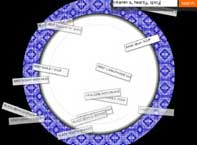Hugo Liu, a graduate student at M.I.T.’s Media Lab, has developed a cookbook that can recommend a dish on the basis of some of the tastes and emotions commonly associated with it. An artificial intelligence robotic reader reads each recipe and based on tastes of the ingredients and the types of cooking procedures, predicts how a food will look, taste, and smell.

Synesthetic Recipes (PDF) is indexed according to 5,000 ingredients and 400 cooking procedures. But it can also be searched according to terms that range from the descriptive (“silky”) and the playful (“aha”) to the referential (“Popeye”) and the temperamental (“brooding”).
First, the M.I.T. researchers mined sources such as online food sites, records of the culinary historian Barbara Ketcham Wheaton and a catalog of thousands of simple statements (like “butter tastes rich”). They then cross-referenced this information and combined it with a web bank of recipes. Their task essentially amounted to programming a computer with the knowledge that, for instance, a soufflé is ethereal because it’s fluffy, that it’s fluffy because it’s made with well-aerated egg whites and that whipping egg whites aerates them.
Video.
Via The Year in Ideas, The New York Times.
